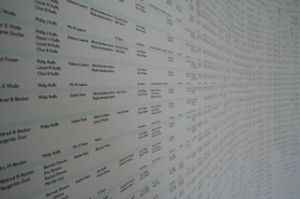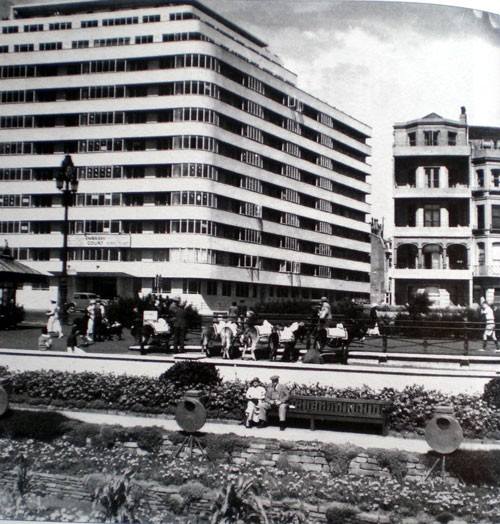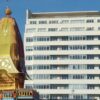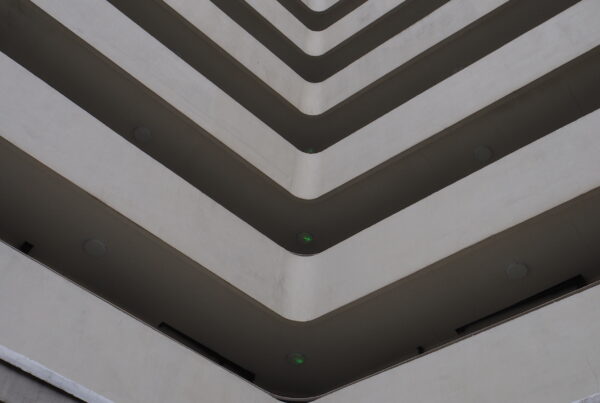Who lived at Embassy Court?
Alas, there is little solid evidence that many of the famous celebrities popularly associated with the building ever leased flats or took up permanent residence here. The novelist, playwright and columnist Keith Waterhouse certainly lived at Embassy Court for many years (see below picture of him in flat 91). Actors and entertainers Rex Harrison, Max Miller and Diana Dors may well have spent some time here. Graham Greene and Lawrence Olivier are likely to have been visitors, if anyone has any further information we would be very pleased to hear it.
Another famous resident was west-end playwright Terence Rattigan who lived here in 1961 and 62. Rattigan was a close friend of Rex Harrison and also knew Graham Greene and Lawrence Olivier well.

Some of our other residents were indeed famous, if not notorious, but only in their day. Popular playwright and high roller Walter C Hackett had addresses in Mayfair and Embassy Court up until 1940. With warrants issued for his arrest, he was forced to flee to New York to escape debts of a then colossal £12,000. One of Hackett’s many plays; “It Pays to Advertise” was revived in 2009 at the Metropolitan Playhouse New York.
And there were some aristocrats too. Embassy Court was home to the 6th Lord Burgh, former officer in the Black Watch regiment and heir to a lapsed medieval title dusted off in 1916 for his more illustrious father. Facing crippling death duties Lord Burgh had already sold off most of his inheritance by the time he moved into his 10th floor flat at Embassy Court in 1939. Divorced following his wife’s affair he was forced to declare himself bankrupt after she stopped his allowance of £100 a month. He had given his last valuable heirloom to a New York model. Brains might not have been his strong suit but there was no doubting his courage. A former officer in The Black Watch, he volunteered as an ambulance driver at the height of the London Blitz while he was awaiting a commission in the Navy.
Embassy Court’s connection with the cream of London society came in the form of Mrs Mary Fludyer. Born in Belgravia, she had been introduced at Buckingham Palace in 1896 following her marriage to a distinguished officer in the Scots Guards. She was destined for a life of glittering tiaras, spectacular gowns and polished brass buttons. In her four decades at the Court of St. James she had met almost everyone it was possible to meet, from the Aga Kahn to the last Tsar of Russia and three Princes of Wales. Her cohorts in charity work were titled ladies whose names spoke of new wealth and ancient privilege in the last years of Empire; Cunard, Jardine, Beauchamp, Fitzroy and many others. She died at home in Embassy Court in 1943, leaving her “ever faithful maid”, Elsie Beckwith, a fountain pen, a wristwatch, £5 and – a return ticket to London.
These people were the exception. The voters’ registers and other directories show the residents of Embassy Court to be solid members of the British middle and upper middle class, and occasionally, their live-in maids and au-pairs. After the Second World War it is these classes that dominate. Embassy Court settled down into a long sunlit afternoon of quiet and unostentatious affluence. Its residents between the 1950s and 1970s included many successful entrepreneurs, senior professionals, barristers, stock-brokers and members of established family businesses, a number of whom had chosen to retire in this secure and well-maintained block at the quieter end of the Brighton sea-front.
Only one resident possessed a Rolls Royce and that was Jack Green, a successful bookmaker from the East End of London. Jack and Rosa Green arrived at Embassy Court in the early 50s and became the building’s lengthiest resident lessees. They were among the few from that period who bought the new 99 year leases offered in the 1970s.
Until 1969, the head porter, retired military man William Harrison, ruled the block from his basement flat ensuring the security of residents with a team of four men and a handy man to keep things working. Rust was his relentless enemy, by the 1960s it was attacking every aspect of the building. With a military discipline, scrupulous attention to detail and an unlimited supply of paint Harrison kept it at bay. It must have seemed like a battle against entropy itself. And ultimately one we all lose. Harrison lost his in 1969. He was replaced by another long-standing caretaker John Corish. These may have been the last people for several decades who made it their personal mission to take care of Embassy Court.
Embassy Court’s decline was decades in the making but the rot truly set in during the mid 1980s. A succession of freeholders came and went, seemingly with little interest in maintaining the block. The decline in the value of leases brought speculators and absentee landlords into the picture. During the 1990s some flats were abandoned, others were squatted, rented out to struggling economic migrants and – to the horror of some – students!
These new arrivals at first sat uneasily alongside the often elderly and temperamentally conservative residents who had made their homes here in the 1970s. But attitudes changed as the building fell deep into decay with waves of litigation passing between the freeholder and the beleaguered resident lessees. In the final chaotic years before the renovation something very like a Blitz spirit seemed to arise. By the time the building was restored in 2005 the sense relief was shared by all and that sense of shared communal feeling still pervades Embassy Court today.
The renovation brought new residents, many professionals, including architects, into the block. But Embassy Court today has a life too diverse to categorise. People of widely differing ages, social strata, occupations, ethnic and cultural backgrounds live happily side by side in ways that would seem impossible in many parts of the world.

Here and When – foyer display showing residents 1936-1990
Here & When - foyer display of residents 1936-1990
The wall display shows the names of many of the people who have lived in Embassy Court. The information was collected from the electoral registers and local directories available at the Brighton and Hove Local History Centre and presented in the form of a single table showing who lived in which flats for every year between 1936 and 1990.
It is the product of a collaboration between an artist and a historian and belongs to both of these fields. It represents a form of knowledge that is forever being created and lost. One that is always slipping away into the past and can never be fully recovered. The many gaps and errors – faithfully copied from the sources – seem to add to its poignancy.
There is no historical narrative, the data is presented so that it speaks directly. And the incompleteness and uncertainty of it is part of the work. Our minds are conditioned to find patterns and stories in the slightest of information and we can see them here. Children appear, sometimes with their birthdays recorded. Long stable relationships can be seen, ending perhaps in tragedy and loneliness. And there are many mysteries. What we see in this data depends on who we are.
Stories
“I was an evacuee, aged 8, and arrived on 2nd Sept. 1939 with two teachers from St. Mary’s school, Vincent Place Victoria. We were billeted with a Miss Smith, at number 13, Embassy Court.
On the following day war was declared, and we looked out to the beach, on which there were rolls of barbed wire. If the weather had been clearer we thought we might have been able to see across to France. Hitler was very close!”

“My Grandmother “Kitty ” and her partner ” Uncle Jack” occasionally lived at their appartment in Embassy Court from 1950’s – 1970’s – they also had a house in Maida Vale – I think they only came to Brighton in the Summer – I can remember visiting and being greeted by smartly dressed Porters – all very sleek and polished – there was a bell for the maid – the porters would collect the mail – beautiful lead glassed interior doors – deco fitted wardrobes – full of her furs and handbags – pink deep pile carpets – horseracing on the tv all day it seemed – but very grand. My grandmother used to drink in pub opposite and her partner “Jack ” would call into a drinking/gambling club nearer to Norfolk Square – which seemed a bit seedy – they had a caricature of him in the bar – “king of the spoofers”
“Hello my name is Jackie Harrison and William Robert Harrison was my Grandad. Sadly I was only a small baby when I paid my very first visit to Embassy Court Brighton back in April 1966 when I was only months old ! My Grandad was the live in Caretaker at the time and took his role very seriously as not only was it his job it was also his home as he and my Nan lived in the basemant flat. Very sadly after this, only weeks later , on the 2nd May 1966 my Grandad very suddenly passed away in the night .Grandad William Robert Harrison died of pneumonia at the age of 69 on the 2nd May 1966 only 7 days from his 70th birthday.He was actually buried on what should have been a great happy day. Born and buried on the same date !9th May! My poor nan was heart broken and fell into shock. She was actually told to vacate Embassy Court by the end of the week!!.Earlier this year I was so happy to find a brilliant Tapestry just inside the entrance doors to Embassy Court. There on the wall were all the names of previous residents and there for my own eyes to see were my Nan and Grandad’s names( and my Uncle Noel’s too as he lived with them for a very short time ) I couldn’t believe it! He would have been SO VERY happy to see that he hadn’t been forgotten and that my nan had her name there too!. A brilliant bit of family history for me to share with my 2 boys about their great grandad and for me to tell my dad too who is now 84 years young…one of William Robert and Rose Ann Harrison’s sons…..”
“I was a telegram boy in the 1960s and I dreaded delivering to Embassy Court because the foyer was thickly carpeted and the staff at the Reception Desk would insist on examining my shoes to make sure that they were clean enough to enter the building. Even the Metropole didn’t do that!”







